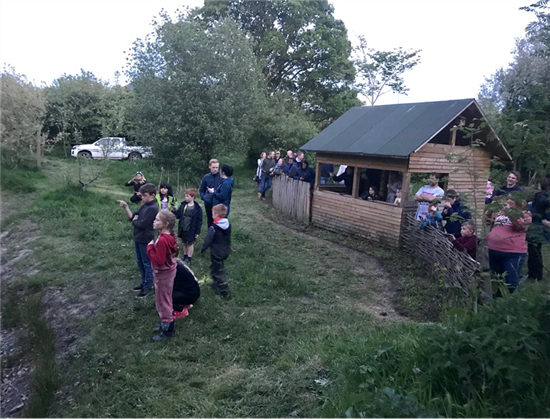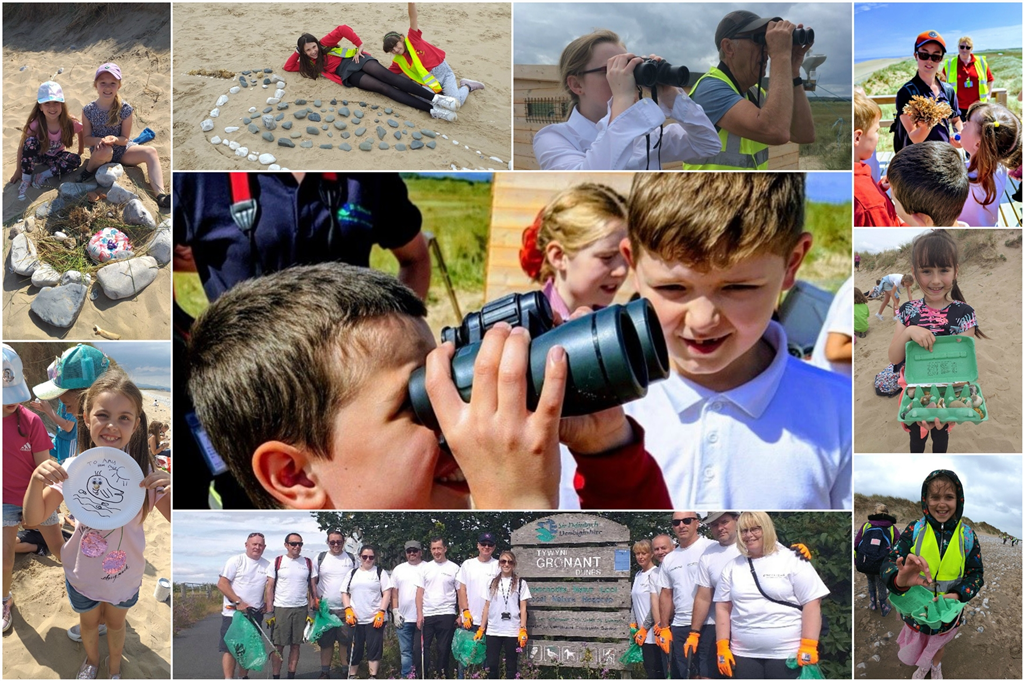Countryside Services
Glasdir: living classrooms inspiring children’s interest in nature
Countryside Service has been working on an exciting living classroom partnership with Rhos Street Primary School.
A number of years ago, Countryside Service took over the management of Glasdir in Ruthin, as mitigation land for a new nearby housing estate, with a view to creating a partnership with the local school. Over the past few years, Countryside Service staff worked hard to transform this overgrown area into a haven for wildlife.
We have been working on an area of willow with ditching, which has been identified as ideal water vole habitat. The school have been helping to coppice the willow along the banks of the ditches to allow more light into the water. Further into the site, we are continuing to improve the pond, which was excavated in 2017. Pupils got involved in planting native wildflower plugs, a mixture specially selected for its suitability to wetland habitats. The children enjoy birdwatching from the hide, also built in 2017.
 The bird hide
The bird hide
Recently, pupils planted an orchard consisting of Denbigh plum, Welsh Cox and Nant Gwytheyrn apples. After camera traps were installed, the children enjoyed viewing footage of mammals, including badgers and foxes, exploring the site. They have also been learning about insect pollinators with the installation of solitary bee boxes, which are proving popular with red mason and leafcutter bees. The newly-planted wildflower turf has been a great success, with the resulting bloom shown in the photo.

Wildflower turf in bloom
Earlier this year, we hosted an open evening at Glasdir to give families of the school pupils a chance to see their work. Families enjoyed exploring the site, and had a go at using bat detectors.

Bat detectors in use at the family evening event
In June, Maria Golightly from Grow Wild Wales visited the Living Classroom, along with project leaders from the Morfa Gateway Project in Prestatyn. They were greatly impressed by the efforts of both the Countryside Service and the school. During the visit, pupils installed signs for the orchard trees, and enjoyed some moth trapping.

Moth trapping with Maria from Grow Wild
The children look forward to getting outside, learning about nature and doing something different to traditional lessons. “Rhos Street School is proud and enthusiastic to be part this unique partnership. ‘The Living Classroom’ enables us to provide meaningful and enjoyable environmental tasks and experiences in the wider countryside. This hands-on experience is vital for the children to recognise and value the role they play in a sustainable future”, said Joanne Davies, Eco Co-ordinated, Rhos Street School. We will be continuing our work with Rhos Street School at Glasdir in the Autumn term, and hope this project will spark an interest in nature for future generations.
New Road Verge Policy
 Roadside verges have become increasingly important on a local, national and international setting people are becoming aware of their importance as havens for wildlife, plants and pollinators. Unlike many other grassland habitats, the road verges have been left primarily untouched by fertilisers, pesticides or herbicides that can have detrimental effects on our wild species.
Roadside verges have become increasingly important on a local, national and international setting people are becoming aware of their importance as havens for wildlife, plants and pollinators. Unlike many other grassland habitats, the road verges have been left primarily untouched by fertilisers, pesticides or herbicides that can have detrimental effects on our wild species.
There are over 700 species of plant that have been recorded in Britain on road verges (45% of all our flora species). This includes some very rare examples, such as the Bithynian vetch (Vicia bithynica) which is listed as a Denbighshire Local Biodiversity Action Plan priority species and as vulnerable on the UK International Union for Conservation of Nature’s Red List. By managing our verges correctly we enable a range of wildlife to thrive; from invertebrates to reptiles, amphibians, birds and small mammals.
Since 1930 the UK has lost 97% of its wildflower meadows while England and Wales have less than 1% of the pre-war total area of unimproved lowland meadow remaining. This catastrophic loss of habitat has had massive detrimental effects on insect and plant populations across the UK. For instance, numbers of invertebrate species such as butterfly, moth and ground beetle are showing a decline of between 65 – 70% over recent decades, with many more species now highly threatened.
A report titled ‘The State of Britain’s Butterflies, 2015’ noted that 76% of the UK’s resident and regular migrant butterfly species had declined in either abundance or occurrence (or both) over the past four decades (Fox et al., 2015). While a study by Goulson et al. in 2008, noted that three of the 25 bumblebee species in the UK had become extinct with another eight species experiencing drastic population shrinkages.
Sadly, the outlook for bees is no better. The European Red List of Bees, indicated that a lack of information has severely limited establishing the status of bee species populations, with 79% of the species having unknown population trends. Unfortunately there is currently no official data for trends in wild bee populations for Wales, so populations may be heading towards extinction faster than we think.
The Council’s new verge policy
We are looking to reverse the decline in pollinators and other invertebrate species through the creation of wildflower rich habitats along our road verge network by implementing its new road verge policy.
For the first time, our Corporate Plan has a section on the environment which has included bees as a priority species within the county. With this in mind, the council’s new road verge policy will attempt to increase the overall available habitat and food sources for bees and other pollinators while maintaining the safety of its road users.
The new policy has been developed in conjunction with the North Wales Wildlife Trust, the Bodfari Woodland Skills Centre and a local group (Life on the Verge), with whom the council has worked with for over 10 years.
The verge policy focuses on roads outside the 30-40mph limit and non-principal roads. These roads will be cut once a year after the 1st August, in what will be known as a biodiversity cut. This will also include the removal of the cuttings (where appropriate) which will reduce the nutrients re-entering the soil and limit the growth of brambles, nettles and other more rapidly growing nutrient-loving species in favour of the more slow growing wildflower species.
This cut will be done on roughly 78% of the total road verge network in the county and is made up of over 1,800km of potential wildflower habitat. The single biodiversity cut allows enough time for plants to flower and seed while ensuring a prolonged period of feeding for pollinators and other insects who are then also able to lay their eggs in safer habitats.
A safety splay of 1m wide will still be in place (where appropriate) to ensure the safety of Denbighshire’s road users while also enhancing and developing our road verges as wildlife rich corridors.
We ask all Denbighshire residents to please get behind this policy and help us increase our counties biodiversity by not cutting road verges, even if they do look a little untidy. Wildflower meadows will look better and better over time as they establish themselves, so we can all look forward to having wonderful wildlife and pollinator friendly road verges throughout our beautiful county as Denbighshire aims to become the most ‘Bee Friendly’ county in Wales!

A season of successes for Gronant Dunes and the Little Terns
“Possibly the BEST DAY EVER!”, “I don’t want to leave!”, “Thank you so much for bringing us here!”
These are just some of the sentiments that have been said this season from the school groups that have visited Gronant and the little terns.
This season saw the beginning of a new focus for the little tern colony at Gronant, which was brought on by the transition from EU Life+ funding to the Welsh Government’s Landfill Disposal Tax Community Scheme, administered by the Wales Council for Voluntary Action (WCVA).
The focus was to introduce this site with all its wonders to the local communities of Rhyl and Prestatyn to help in the conservation of the little terns and other resident species.
For the community to be able to help conserve the Gronant dunes site and the inhabiting species, they first need to know about it. It is a tucked away site that even some people who have lived there all their lives don’t know about. The best way to achieve this is through schools. They are the keystones of the local communities that have far reaching effects, because if you can inspire the children and the teachers the message will be passed onto the parents and onwards. In total five primary schools and one secondary school took part, with three to four classes visiting from each, totalling 450 children and teachers. At this age everything is exciting, and this enthusiasm is key to learning. So, instead of just showing and telling about the terns, they learnt through actively taking part.
The outdoor classroom was heavily based around the beach, because what child doesn’t love the beach? The terns provided a good focus for the day. After showing them the colony, they went to the beach and took part in activities that allowed them creative freedom while just being allowed to be children and play. This included beachcombing and making egg box treasure chests, building little tern nests, making little tern beach murals, painting Gronant rocks, crafting sea creatures, and some little tern based beach games.
We have set off a ripple effect. We are getting more families and more members of the public out and about enjoying the outdoors, encouraging the development of a more respectful attitude towards their surrounding environment and the desire to get involved in its conservation.
And of course, what about the terns?

Have they had just as good a season as us? The answer is undoubtedly yes! This has been one of the best seasons yet, with good levels of protection from 3km of electric fencing put up by Council staff and North Wales Little Tern Group volunteers, and sterling wardening by both we have seen low levels of predation, which alongside favourable weather conditions have put us on track for record numbers of fledglings.
So a season of successes all round!
For this work to continue the critical thing is to promote communal ownership of our natural spaces and environment, these are our spaces to enjoy and protect. It isn’t solely the job of local authorities, NGOs, or other landowners, it is the job of all of us who use and enjoy these sites. The community and the terns exist in symbiosis at Gronant, mutual benefits are gained by each other’s presence, thus making the funding from the WCVA so critical to both. These natural spaces are all of ours’, for the benefit of nature and the community, that’s what we hope to show here at Gronant.
